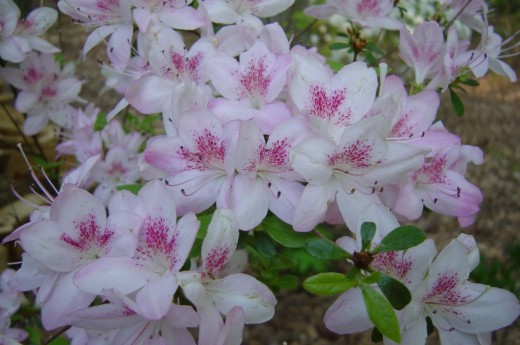Growing Rhododendrons

Rhodos and azaleas are two of the most beautiful woodland plants that can thrive in your garden. There are over 1000 varieties of rhododendrons, most with showy, colorful flower displays. They range in size from tiny species just inches tall to mid-sized shrubs to R. giganteum, which can reach 30 meters tall.
Rhodos are widely distributed throughout the world, occurring naturally almost everywhere except South America and Africa.
Most familiar to gardeners are the cool-climate evergreen species with their colourful blooms, originating in the Himalayas, southwestern China and northern Myanmar. Others are native to and scattered across northern Asia, Europe and North America.

Landscapers love both species and hybrid rhododendrons (including azaleas) for their structure, size, colorful flowers, and the fact that many of them are evergreen. They are generally grouped in mass, with varieties that bloom around the same time, and flower colors that complement each other. Larger-leafed rhododendrons are used in informal plantings and woodland gardens, or as specimen plants. Larger rhododendrons can be pruned to develop a tree-like form.
Cultivating Rhodos and Azaleas
Rhododendrons have fairly shallow fibrous roots and prefer light, well-drained acid soils high in organic material and a pH between 4.5 and5.5. Mulching and careful watering are important, especially before the plant is established. In areas with poorly-drained or alkaline soils, rhododendrons can be grown in raised beds using acidic mediums such as composted pine bark. They prefer some shade, in a moist woodland setting, but if well mulched and irrigated, they can flourish in many locations. Because of their shallow roots, little or no cultivation should be done around the plants. Instead, weeds should be pulled or cut off; or better still, deep mulch will prevent most weed growth as well as retain ground moisture.

Propagation
Although readily available in most garden centers, rhodos can be propagated at home without too much trouble, and some patience. Rhododendrons may be started from seed,or can be rooted from cuttings or by layering.
With layering, cut a tongue on the underside of a low branch, less than halfway through, leaving the end of the branch partially attached to the mother plant. Slant the cut toward the branch's tip, and bury the branch with 2 - 3 inches of soil. Rooting may take several months. Rooting hormone can be applied to the cut area to speed the rooting process.
Aids for Plant Propagation
Cuttings Propagation
Propagating from cuttings is done mid July to early fall (September-October), as the new growth is just hardening off (known as semi-hardwood). Take the cuttings in the morning, when the plant is most turgid. Choose firm pliable wood just beginning to brown at the base, with mature leaves and no flower buds (flower buds are much larger than leaf buds). Cuttings should be 3-6 inches long, and the leaf area needs to be reduced by removing all but the top two-three leaves from the whirl and cutting back the remaining leaves by a third.
Cut the stem at the base at a 45 degree angle, to allow for greater surface area.
Stick the cutting in a rooting hormone (number 2 or 3), shake off excess, and stick the cuttings into a mix of 50% peat moss, and 50% horticultural perlite or vermiculite, in a sterile pot.
Place in a greenhouse or cover the potted cutting with a clear plastic bag (keep the plastic from touching the foliage). The plastic should be loose to allow for air circulation. Keep out of direct sunlight, and keep well misted. Bottom heat and extra lighting will encourage root growth.
Rooting takes about 6 weeks for evergreen azaleas and 3 to 4 months for large-leaf rhododendrons. Once rooted, pot or transplant the cuttings to 10cm pots into a sterile mix of 60% peat moss and 40% perlite, with a slow release fertilizer such as Osmocote. Remove any terminal buds to promote sturdy well-branched plants, and harden the plants off slowly, both to temperature and light.


General Care
Care for your plants by feeding them in late winter or early spring with slow-release fertiliser peilets, or by top-dressing with blood and bone and well-decayed compost, coconut fibre, rice hulls or leaf mould. After blooming, deadhead the flowers to encourage a bushier habit in young plants. Be careful not to remove next season's flower and leaf buds.
Rhododendrons can live for many years in containers, an option for growers with difficult soils. There are specialised mixes available, but a freely draining, general-purpose potting mix will do. Plants in containers need extra watering. Plants growing together can be watered reliably by drip irrigation.
Most of the few problems that afflict rhododendrons can be solved by simply improving the growing conditions, rather than by chemical means. Generally, rhododendrons are sickened by excessive pampering. Practice careful neglect with established rhododendrons which are performing satisfactorily. Keep your plants moist and in reasonably good soil and they will give you pleasure and exotic color for years.
The American Rhododendron Society
- The American Rhododendron Society Welcomes You
The purpose of the Society is to encourage interest in and to disseminate knowledge about rhododendrons and azaleas.










